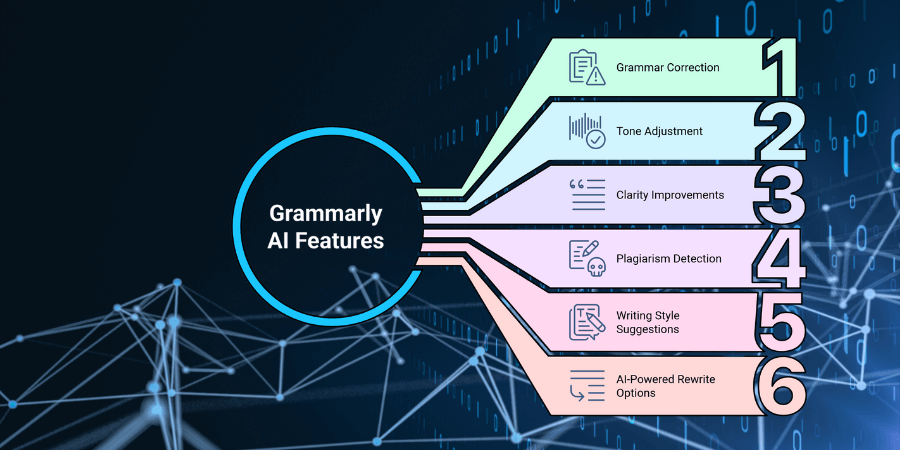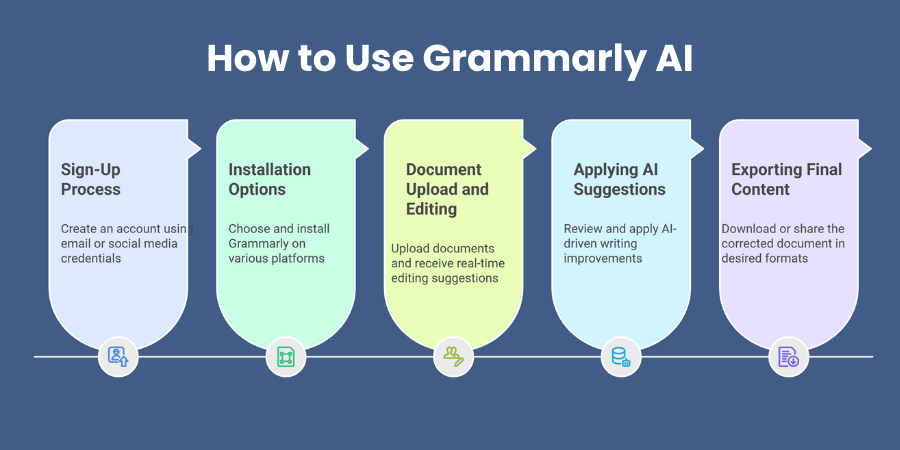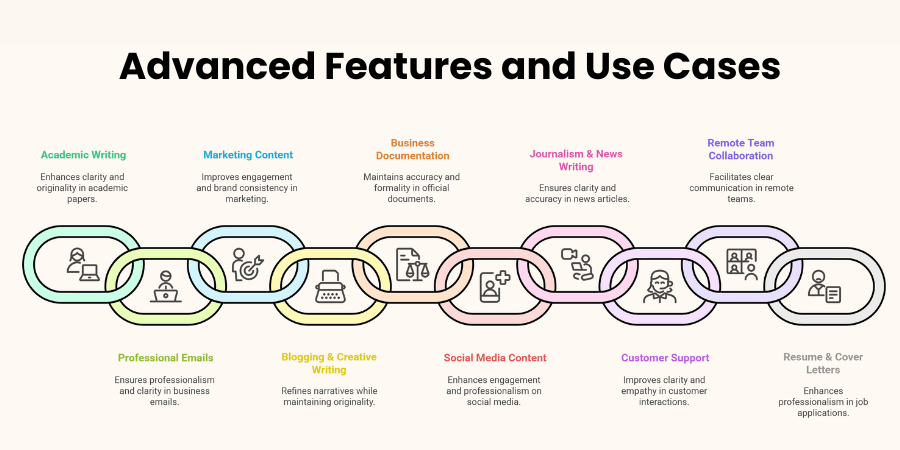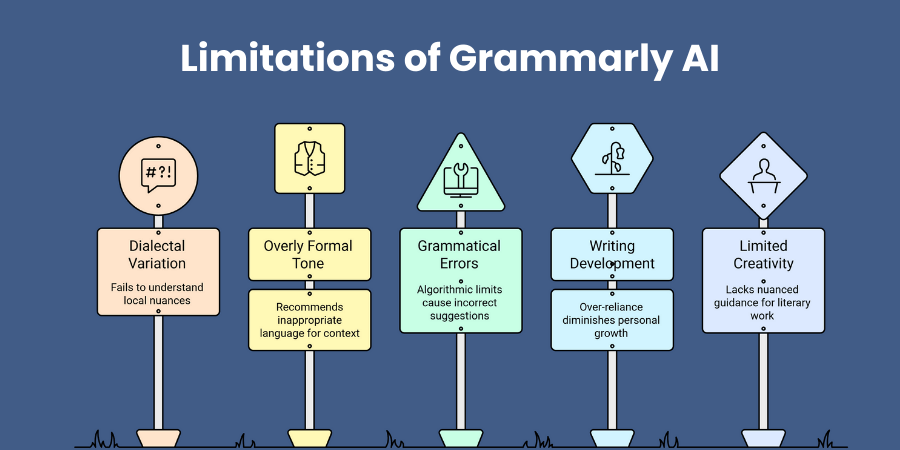Mastering Grammarly AI: Advanced Features, Use Cases, and Writing Tips

Table of Contents
The landscape of written communication has transformed dramatically with the emergence of AI-driven writing assistants. If you want to take your writing to the next level, learning how to use Grammarly AI effectively is essential. This powerful tool represents a significant advancement in how you can approach editing and proofreading across various contexts.
Using Grammarly AI properly means understanding its capabilities beyond simple spell-checking functionality. Whether you are a student completing assignments, a professional drafting important emails, or a business owner creating marketing content, you’ll benefit from mastering Grammarly AI. The platform gives you real-time support for grammar correction, style enhancement, and clarity improvement.
As a writer, you will quickly recognize Grammarly as an indispensable companion for producing polished, error-free content efficiently. In the following guide, you’ll explore everything you need to know about maximizing this AI writing assistant.
key takeaways:
- Grammarly AI has transformed how people approach editing and proofreading across academic, professional, and business contexts.
- Grammar correction goes beyond basic spell-check, offering advanced real-time suggestions for clarity and precision.
- Style enhancement helps improve tone, flow, and readability to match different types of communication needs.
- Clarity improvement ensures messages are concise, impactful, and easy to understand.
- Grammarly serves as a reliable tool for producing polished, error-free writing efficiently across industries.
Table of Contents
What is Grammarly AI?
Grammarly AI functions as an advanced writing assistant powered by sophisticated artificial intelligence algorithms. The platform goes significantly beyond traditional spell-checkers by analyzing context, sentence structure, and writing objectives. This comprehensive tool evaluates written content across multiple dimensions including grammar, spelling, punctuation, clarity, engagement, and delivery.
Grammarly AI employs natural language processing to understand the nuances of human communication in written form. The system identifies potential improvements while considering the intended audience and communication purpose. Users receive suggestions that enhance readability, tone consistency, and overall writing effectiveness.
The core value proposition centers on transforming ordinary writing into clear, compelling, and error-free communication. Grammarly AI serves as a virtual writing coach that provides instant feedback on areas needing improvement. The platform adapts to individual writing styles and preferences over time through continuous learning.
Many professionals rely on Grammarly AI to maintain consistent quality across various communication channels. The tool helps users project professionalism and credibility through polished writing. Grammarly AI bridges the gap between basic writing skills and professional-level communication standards.
Key Features of Grammarly AI

Grammar Correction
Grammarly AI excels at identifying and correcting grammatical errors with remarkable accuracy and contextual awareness. The system detects subject-verb agreement issues, improper tense usage, and article problems that might otherwise go unnoticed. Advanced algorithms recognize complex grammatical structures and provide appropriate corrections based on sentence context.
Users receive explanations alongside correction suggestions to improve understanding of grammatical principles. The platform identifies patterns in writing errors, helping users recognize recurring mistakes in their writing style. Grammar correction extends beyond simple rules to include idiomatic expressions and regional language variations.
Tone Adjustment
The tone detector analyzes writing to determine emotional signals and communication style within the text. Users can select from various tone options including formal, informal, confident, or friendly based on their audience. Grammarly provides real-time feedback on whether the current tone matches the intended communication style.
The system offers specific word choice suggestions to shift tone appropriately for different contexts. Professional emails, academic papers, and casual messages each require distinct tones that Grammarly helps maintain consistently. This feature proves particularly valuable when communicating across cultural boundaries or in sensitive professional situations.
Clarity Improvements
Grammarly AI identifies unnecessarily complex sentences and suggests simpler alternatives for improved readability. The platform highlights wordiness, redundancies, and unclear references that might confuse readers. Users receive suggestions for restructuring sentences to convey ideas more directly and effectively.
The clarity score provides an objective measurement of how easily readers can understand the content. Grammarly identifies passive voice constructions and offers active alternatives when appropriate for clearer communication. The system also detects jargon or technical language that might require simplification for general audiences.
Plagiarism Detection
Premium versions include sophisticated plagiarism checking against billions of web pages and academic papers. The system highlights text segments that match existing content and provides source information for proper attribution. Users can verify originality before submission to avoid unintentional plagiarism in academic or professional contexts.
This feature proves especially valuable for students, researchers, and content creators concerned with originality. The plagiarism checker identifies both direct quotes and paraphrased content requiring citation. Regular scanning helps maintain academic integrity and professional credibility in written work.
Writing Style Suggestions
Grammarly analyzes writing patterns to provide personalized style recommendations based on document type. The platform identifies overused words and phrases, suggesting varied alternatives to enhance writing quality. Style suggestions include vocabulary enhancements that elevate the sophistication level of the content.
Users receive feedback on sentence variety, paragraph structure, and transition usage for improved flow. The system detects inconsistencies in formatting, capitalization, and punctuation throughout documents. Style recommendations adapt to different writing contexts including academic, business, creative, or technical content.
AI-Powered Rewrite Options
Grammarly’s newest features include paragraph-level rewriting suggestions for comprehensive text improvement. Users can transform awkward or unclear passages into polished content with a single click. The rewrite function maintains the original meaning while enhancing clarity, conciseness, and engagement.
Multiple rewrite options allow users to select the version that best matches their intended voice. This feature proves particularly useful for non-native English speakers seeking natural-sounding expressions. The AI rewrites consider document context to ensure consistency throughout the entire piece.
How to Use Grammarly AI: Step-by-Step Guide

Sign-Up Process
Creating a Grammarly account requires only an email address and password through the official website. Users can alternatively sign up using existing Google or Facebook credentials for faster access. The platform offers immediate access to free features after account creation without requiring payment information.
New users should select their primary English dialect preference during setup for appropriate suggestions. The initial questionnaire helps Grammarly understand writing goals and customize the experience accordingly. Account creation takes approximately two minutes and provides instant access to the web-based editor.
Installation Options
Grammarly offers multiple installation options to suit different user needs:
- Browser extension for Chrome, Firefox, Safari, and Edge
- Desktop application for Windows and Mac systems
- Mobile keyboard integration for iOS and Android devices
- Office integration for Microsoft Word and Outlook applications
Document Upload and Real-Time Editing
Users can create new documents directly in the Grammarly Editor with automatic saving functionality. The platform accepts document uploads in various formats including .docx, .txt, and .pdf files. Real-time suggestions appear as you type, with colored underlines indicating different issue types.
The interface displays a sidebar summarizing all detected issues categorized by type. Users can click on underlined text to view specific suggestions and explanations for each issue. The real-time performance score provides immediate feedback on overall writing quality during composition.
Applying AI Suggestions
Grammarly presents suggestions with clear visual indicators showing the severity of each issue. Users can accept suggestions individually by clicking on them or hovering for implementation. The platform allows batch correction of similar issues throughout the document for efficiency.
Each suggestion includes an explanation of the grammar rule or writing principle involved. Users maintain full control, with the option to ignore suggestions that conflict with stylistic choices. The interface tracks changes and allows comparison between original and edited versions.
Exporting Final Content
Completed documents can be downloaded in various formats including Word, PDF, and text files. The platform allows direct copying of corrected text to clipboard for pasting elsewhere. Users can share documents directly from Grammarly via email or shareable links.
Export options include or exclude Grammarly’s correction marks based on user preference. The system performs a final check before export to ensure all critical issues have been addressed. Integration with cloud storage services allows saving directly to Google Drive or Dropbox.
Advanced Features and Use Cases
Grammarly goes far beyond basic grammar correction. Its advanced features and diverse use cases make it a powerful writing companion for students, professionals, businesses, and content creators. From detecting tone and refining style to enhancing clarity and ensuring originality, Grammarly adapts to different needs across industries.

Whether you’re drafting academic work, preparing business documents, or creating engaging marketing content, these features and applications show how Grammarly transforms everyday writing into polished communication. Here are some business use cases you may need to know:
1. Academic Writing
Overview: Academic writing requires precision, structure, and clarity. Grammarly supports students and researchers by strengthening sentence construction and ensuring originality.
Industries Served: Education, research institutions, universities, and online learning platforms.
How It Works: The tool checks grammar, improves clarity, and highlights potential plagiarism. It also maintains academic tone and citation integrity.
Impact: Students and researchers submit error-free, credible, and professional work that meets academic standards.
Real-World Example: A graduate student uses Grammarly to refine a dissertation, improving readability, fixing citation errors, and ensuring originality.
2. Professional Emails
Overview: Business communication depends on professionalism. Grammarly ensures emails are error-free, polite, and aligned with workplace etiquette.
Industries Served: Corporate offices, HR, consulting firms, and client-facing industries.
How It Works: Grammarly reviews grammar, adjusts tone for professionalism, and eliminates unnecessary jargon that weakens clarity.
Impact: Professionals build trust and credibility with colleagues, clients, and executives.
Real-World Example: An HR manager writes an offer letter using Grammarly, ensuring it sounds both formal and approachable.
3. Marketing Content Creation
Overview: Marketing teams must create persuasive content that influences audiences. Grammarly ensures messages remain error-free and engaging.
Industries Served: Digital marketing, advertising, e-commerce, and publishing.
How It Works: Grammarly enhances word choice, improves tone for target audiences, and ensures brand voice consistency across campaigns.
Impact: Marketers publish high-quality content that drives conversions and strengthens brand authority.
Real-World Example: An e-commerce brand uses Grammarly to refine ad copy and product descriptions, resulting in higher customer engagement.
4. Blogging and Creative Writing
Overview: Bloggers and creative writers need expressive yet structured language. Grammarly helps refine narratives without losing originality.
Industries Served: Media, entertainment, lifestyle, and publishing.
How It Works: The AI offers readability checks, vocabulary alternatives, and tone suggestions to maintain engaging storytelling.
Impact: Writers publish polished blogs and stories that attract wider audiences and maintain engagement.
Real-World Example: A lifestyle blogger relies on Grammarly to enhance flow and readability in travel blogs, boosting reader interaction.
5. Business Documentation
Overview: Official documents require accuracy, formality, and consistency. Grammarly ensures businesses maintain professionalism across reports and contracts.
Industries Served: Legal, corporate, finance, consulting, and government agencies.
How It Works: Grammarly reviews formatting, grammar, punctuation, and tone to align with industry standards.
Impact: Organizations maintain professionalism and avoid costly communication errors.
Real-World Example: A consulting firm uses Grammarly to refine financial reports before client presentations, ensuring credibility.
6. Social Media Content
Overview: Social media posts must be concise, error-free, and engaging. Grammarly refines tone and wording for maximum impact.
Industries Served: Influencer marketing, PR, startups, and brand management.
How It Works: The tool adapts tone to platforms, ensures clarity within character limits, and removes grammatical errors.
Impact: Brands build stronger reputations with professional, engaging social media presence.
Real-World Example: A startup founder uses Grammarly for LinkedIn updates, boosting credibility and audience engagement.
7. Journalism and News Writing
Overview: Journalists must deliver clear, factual, and professional content under pressure. Grammarly helps refine articles without losing accuracy.
Industries Served: Newspapers, online publications, media outlets, and broadcasting.
How It Works: Grammarly ensures grammar accuracy, removes redundancy, and keeps tone professional and consistent with editorial standards.
Impact: Newsrooms publish timely, polished content that builds reader trust.
Real-World Example: A journalist covering breaking news uses Grammarly to edit quickly, ensuring clarity before online publication.
8. Customer Support Communication
Overview: Customer support relies heavily on professional, empathetic, and clear communication. Grammarly assists teams in maintaining tone and accuracy.
Industries Served: SaaS, retail, telecom, e-commerce, and BPO services.
How It Works: Grammarly tailors tone for customer interactions, fixes grammar, and ensures professionalism in chat, email, and ticket responses.
Impact: Companies improve customer satisfaction by delivering clear, empathetic support.
Real-World Example: A SaaS company equips support teams with Grammarly, reducing miscommunication and improving resolution times.
9. Remote Team Collaboration
Overview: Remote teams depend on written communication for coordination. Grammarly ensures clarity across chats, documents, and emails.
Industries Served: IT, startups, freelancing platforms, and global enterprises.
How It Works: The tool integrates with Slack, Gmail, and project management tools to refine messages.
Impact: Teams avoid misunderstandings, strengthen collaboration, and save time.
Real-World Example: A software development team uses Grammarly in Slack to keep project updates precise and professional.
10. Resume and Cover Letter Writing
Overview: Job seekers need compelling resumes and cover letters to stand out. Grammarly refines wording for professionalism and impact.
Industries Served: Recruitment, HR, career counseling, and professional services.
How It Works: Grammarly checks grammar, eliminates redundancy, and suggests stronger vocabulary for professional presentation.
Impact: Candidates gain more interview opportunities by presenting polished, professional applications.
Real-World Example: A fresh graduate uses Grammarly to improve a resume and cover letter, securing multiple job interviews.
Grammarly AI Pricing Plans
| Plan | Price | Key Features | Best For |
| 無料の | $0 | Basic grammar checking, Spelling correction, Punctuation fixes | Casual writers, Students |
| Premium | $12/month (annual billing) | Advanced grammar suggestions, Tone adjustments, Plagiarism detection, Full-sentence rewrites | Professionals, Content creators, Students |
| Business | $15/user/month | Team management features, Style guide creation, Priority support, Admin controls | Small businesses, Marketing teams, Publications |
| Enterprise | Custom pricing | SSO integration, Advanced analytics, Dedicated account manager, Volume discounts | Large organizations, Educational institutions |
The free plan provides essential writing support suitable for basic proofreading needs. Premium subscriptions unlock the complete feature set with significant advantages for professional writers. Business plans include collaboration tools and centralized management for organizational consistency.
Enterprise solutions offer customized implementation with dedicated support and security features. All paid plans include mobile and desktop applications alongside browser extensions. Grammarly frequently offers promotional discounts for first-time premium subscribers.
Limitations of Grammarly AI
Despite its capabilities, Grammarly occasionally misinterprets context in highly specialized or technical writing. The system sometimes suggests unnecessary changes to intentionally creative or unconventional writing styles. Users should remain vigilant about accepting suggestions in specialized fields with unique terminology.

Common limitations of Grammarly AI include:
- Difficulty with certain dialectal variations and culturally specific expressions
• Occasionally recommending overly formal alternatives in casual contexts
• Incorrect suggestions for complex grammatical constructions due to algorithmic limitations
• Potential to diminish personal writing development through over-reliance
• Less creative guidance compared to human editors for nuanced literary work
• Missing subtle tone issues that human readers would immediately recognize
Privacy concerns exist regarding document analysis, though Grammarly maintains strict data protection policies. The tool requires internet connectivity, limiting functionality in offline environments. Premium features represent a significant investment for individual writers with limited budgets.
Best Practices for Using Grammarly AI
Successful Grammarly users maintain a balance between accepting AI suggestions and preserving personal voice. Reviewing each suggestion critically rather than accepting all changes automatically preserves authenticity. Writers should understand the reasoning behind suggestions rather than making blind corrections.
Customizing Grammarly’s goals for different document types improves suggestion relevance significantly. Setting the appropriate formality level before writing ensures contextually appropriate recommendations. Users benefit from creating personal dictionaries for specialized terminology in their field.
Regular software updates introduce new features and improve existing functionality over time. Exploring the performance statistics helps identify patterns in writing that need improvement. The most effective approach combines Grammarly’s technical suggestions with human judgment.
Writers should consider Grammarly a collaborative tool rather than a replacement for critical thinking. The platform works best when users already understand basic grammar principles and writing conventions. Combining automated checking with occasional human proofreading provides optimal results.
Future Trends for Grammarly AI
What to Expect in Writing Assistance
Grammarly continues developing more sophisticated context understanding for increasingly accurate suggestions. Future versions will likely offer deeper structural analysis for comprehensive document reorganization. Enhanced personalization will adapt to individual writing styles with greater precision.
Industry trends suggest integration with voice-to-text platforms for seamless dictation and correction. Expanded language support beyond English appears on the development roadmap for global accessibility. Advanced features may include automated citation formatting and reference management capabilities.
Real-time collaboration features will likely expand for team-based writing and editing workflows. The platform may introduce specialized modules for different industries with unique communication requirements. Integration with project management tools could streamline content production processes.
How Artificial Intelligence Will Transform Writing
AI writing assistance will increasingly focus on enhancing creativity alongside technical correctness. Future systems will likely provide structural suggestions based on successful content patterns. Predictive text capabilities will evolve beyond word-level to paragraph-level recommendations.
Machine learning advances will enable more nuanced understanding of emotional impact in writing. AI may eventually generate alternative versions of content optimized for different audiences. Automated content optimization for specific platforms and contexts will become more sophisticated.
The boundary between editing and co-creation will blur as AI capabilities continue advancing. Writers will increasingly collaborate with AI systems throughout the creative process. Ethical considerations regarding AI attribution and assistance disclosure will become more prominent.
Conclusion
Mastering how to use Grammarly AI effectively transforms the writing experience across personal and professional contexts. The platform offers comprehensive support from basic grammar correction to sophisticated style enhancement. Users who understand both the capabilities and limitations achieve optimal results from this powerful tool. How to use Grammarly AI successfully involves balancing automated suggestions with personal judgment and style preferences. The platform serves as a valuable writing partner rather than a replacement for human creativity. Writers across all proficiency levels can benefit from incorporating this AI assistant into their regular writing process. The investment in learning how to use Grammarly AI effectively pays dividends through improved communication quality and efficiency.
Frequently Asked Questions
Is Grammarly AI safe to use with sensitive or confidential documents?
Grammarly employs enterprise-grade encryption and security measures to protect user data. The company maintains a strict privacy policy regarding document content and user information. Users with highly sensitive materials should review the specific security documentation or consider offline alternatives.
Can Grammarly AI completely replace human proofreaders?
Grammarly excels at identifying technical errors and many stylistic issues with high accuracy. However, human proofreaders still offer advantages in understanding nuanced context and creative elements. The optimal approach combines AI efficiency with occasional human review for important documents.
Does Grammarly work with languages other than English?
Currently, Grammarly primarily supports English with variations including American, British, Canadian, and Australian dialects. The company has indicated plans for expanding language support in future updates. Non-English writers should verify current language capabilities before subscribing to premium plans.
How does Grammarly AI handle technical or specialized writing?
Grammarly provides reasonable support for technical writing but may struggle with highly specialized terminology. Users can add specialized terms to their personal dictionary to prevent incorrect flagging. Technical writers should review suggestions carefully, particularly in fields with unique conventions.
Shaif Azad
Related Post
How to Use Canva AI to Create Stunning Designs, Videos, and Copy Easily
Have you ever wished your designs could build themselves while you focus on ideas? Canva now...
How to Use Sora AI: A Complete Guide to Creating Stunning AI Videos
Have you ever imagined turning your ideas into stunning videos in minutes, without needing to touch...
Cline vs Cursor: Choosing the Best AI Coding Assistant for Developers
Have you ever imagined what it would be like if coding could feel faster, smarter, and...




